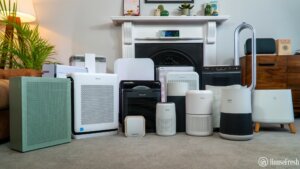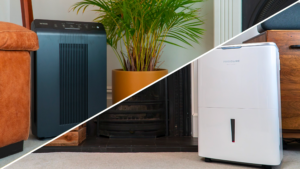Whether you’re reading this because you can’t stand the sight of dust or it’s significantly impacting your health, you’ve come to the right place.
We’ll explore dust and why it’s so hard to remove. We’ll also look at the various health effects of dust, from aggravating allergy symptoms to causing serious lung conditions.
The good news is that our step-by-step guide on effectively removing dust from the air should help put your mind at rest. You’ll find simple key actions like frequently vacuuming, decluttering and using a high-quality air purifier.
So, read on to learn how to beat dust.
What is dust, and what makes it so hard to remove?
We might all recognize what dust looks like, but it can be harder to define it. One reason for this could be that it’s made up of so many different elements. These include shed skin cells, hair, pet dander, pollen, soot, mites, microplastics, and even decomposing insects.
Dust is pretty unique and its composition can vary from home to home, depending on whether you have pets. While a good chunk of dust originates inside your home, most comes from outdoors.
It migrates inside via open windows and doors and is tracked in on clothes, shoes and pets. Unfortunately, dust that originates outside may even contain harmful substances such as arsenic and lead.
Dust particles are measured in microns (equal to 1-millionth of a meter) and most of the dust you can see in your home is approximately 10 microns in diameter. Yet it’s the tiny, invisible dust particles that are more concerning. Anything smaller than 10 microns can lead to adverse health effects and get deep inside your lungs.
Try as we all might remove dust, it seems a never-ending battle. But why?
- We, as humans (and also our furry friends), are constantly shedding skin cells and hair. These elements form a collection with other contaminants in the air, and the dust cycle begins again.
- When the dust is disturbed, the particles get recirculated throughout your home, accumulating more contaminants.
- Dust is quite sneaky and can become embedded in carpets, nooks and crannies.
- It’s even possible that dust from an old house may hold legacy pollutants, such as the insecticide DDT, that were made illegal years ago.
Nine tips to help remove dust from the air
1. Use a damp cloth
If you use a dry cloth or feather duster, the dust will get moved around your home and recirculated back into the air. Be sure to choose a damp cloth (microfiber is best) or sponge, as these will capture the most particles and prevent them from being redistributed on surfaces.
Equally, starting with the highest surfaces first means fewer particles will be suspended in the air.
2. Vacuum often
Aim to vacuum at least once a week, but if you have cats or dogs, you’ll probably need to do it more frequently.
It’s super important to vacuum regularly because carpets are havens for dust. However, as with your dusting technique, it’s also crucial to vacuum properly. Using a cleaner with a HEPA (high-efficiency particulate air) filter will effectively capture particles and prevent them from returning to the air. Be sure to change the filter regularly, too.
3. Mop floors
After you’ve dusted and vacuumed, using a wet mop on your floors helps to remove any remaining dust. As mentioned above, avoid cleaning products with harsh/toxic chemicals — warm water with soap will do the job.
Experts at the Merry Maids recommend adding a dash of vinegar to the solution for an even more effective (and eco-friendly) mix.
4. Use an air purifier
A high-quality air purifier is one of the best ways to remove dust in the air. They effectively draw in and capture harmful dust particles (as well as other contaminants like pollen and mold spores) before releasing clean air back into your space.
There are a few key features to look out for. Like vacuums, go for one with a HEPA filter, as this will capture at least 99.97% of airborne particles as tiny as 0.3 microns. For detailed guidance about the best purifiers for dust, check out our recommendations.
Consider the size of your room. If you buy a unit that’s too small for the space, it won’t be able to filter and clean the air properly, so be sure to measure the area beforehand.
5. Leave the dirt outside
As so much household dust originates from outside and gets tracked in on your shoes, removing shoes at the door is essential. Encourage family members and guests to do the same — politely! With guests, for example, you could let them know that you have a no-shoes policy and ask them to bring some comfy socks or slippers.
Placing a doormat by the front door also helps to ensure everyone wipes their shoes before taking them off.
6. Seal cracks and gaps
Gaps around windows and doors are another common way dust can enter your home. Weatherproofing doors and windows and sealing drafty cracks and gaps will help prevent this. It’ll also help your pocket and reduce heating and cooling bills.
Use a caulk sealant around windows and be sure to replace any worn weatherstripping around doors.
7. Change bed linen weekly
Bed sheets can quickly accumulate dead skin cells, germs, dust mites and other nasties. A simple way to reduce dust in the air is to change and launder your sheets and pillowcases at least once a week. You may need to do this more frequently if you or anyone else in your household suffers from allergies.
According to a Good Housekeeping cleaning expert, the hotter the water the better. Choose a wash cycle that uses the hottest water, but just make sure it’s also safe for the sheets’ fabric.
8. Declutter
Dust loves clutter because it allows the dust to accumulate more. Removing unnecessary stuff reduces the dust, so aim to keep your home as clutter-free as possible. This will also make dusting a lot easier, too!
Speaking of getting rid of things, when you’re thinking about replacing carpets, opt for hardwood floors instead, as these are much less likely to collect dirt and dust.
9. Eat at the table
Eating at the table means food debris is less likely to fall to the floor and, therefore, won’t attract insects. Both food debris and insect parts contribute to airborne dust.
If it’s not always possible to use a table, try not to move around too much while you eat, as this is more likely to lead to food debris falling on the floor.
The negative effects of dust on your health
1. Nanoparticles are especially hazardous
As we touched on earlier, it’s the microscopic, invisible dust particles below 10 microns (as small as 0.3 microns) that are the most problematic for your health. These nanoparticles are dangerous because they’re both small enough to be inhaled and large enough to become trapped in the lung tissue.
According to Dr. Ananya Mandal in Medical Life Sciences, the danger of nanoparticles is clear: they may “move through the body, reach vital organs like the brain and cause biochemical damage and even cancer.”
2. Dust triggers allergies and asthma
For people with allergies and asthma; the dust can trigger symptoms. Yet it’s generally the contents of the dust that provokes symptoms such as sneezing, coughing and shortness of breath.
The mites are tiny insects that look like ticks (or aliens) and can only be seen under a microscope. Dust mites love warm, humid places and are often found in bedding, mattresses and carpets. Be sure to check out what we think is the best air purifier for allergies.
According to a study published in Clinical and Molecular Allergy, the allergens of house dust mites are the most common triggers.
3. Dust can lead to serious health problems
As well as impacting your lungs, the very fine particles can enter your bloodstream, according to the authors of a report published by the World Meteorological Organization. The particles may then affect internal organs and lead to cardiovascular disorders.
Larger dust particles can be dangerous, too. Asbestos, for example, produces coarse dust, and exposure can lead to lung cancer, according to the European Union Taxations and Customs Union.
4. Certain groups are particularly at risk
People who suffer from allergies and asthma are at risk, yet dust can also cause health problems for others. For example, people with pre-existing conditions such as emphysema, bronchitis, and chronic obstructive pulmonary disease (COPD).
study conducted by the Japan Environment and Children’s Study Group and published in the International Journal of Environmental Research and Public Health found that house dust can impact pregnant women and consequently affect infant development.
Wrapping up
The health problems caused by dust are undeniable, yet you can effectively remove it from your home in many ways. Be sure to vacuum regularly, ideally with a HEPA filter device and use damp, microfiber cloths to dust and change your bed linen weekly. As so much dust comes from outside, it’s also important to remove shoes at the door and seal cracks and gaps around windows and doors.
However, an air purifier is one of the best ways to remove dust. It will capture the tiniest particles, helping safeguard your and your family’s health.
SOURCES
- American Lung Association. (2022). Cleaning Supplies and Household Chemicals. lung.org
- Austin Air Systems. (2018). 10 Tips for Getting Rid of Airborne Dust. austinair.ca
- European Commission. (2021). Dust and nanoparticles. ec.europa.eu
- Environmental Protection Agency. (20220. What is a HEPA filter? epa.gov
- Fassio, F., Guagnini, F. (2018). House dust mite-related respiratory allergies and probiotics: a narrative review. ncbi.nlm.nih.gov
- Fry, K. et al. (2021). What is dust? And where does it all come from? theconversation.com
- Keong, L. et al. (2021). How to Get Rid of Dust, According to Cleaning Experts. nymag.com
- Layton, D.W., Beamer, P. I. (2009). Migration of Contaminated Soil and Airborne Particulates to Indoor Dust. pubs.acs.org
- Mandal, A. (2019). Safety of Nanoparticles. news-medical.net
- Matsumura, K., at al. (2021). House Dust Avoidance during Pregnancy and Subsequent Infant Development: The Japan Environment and Children’s Study. ncbi.nlm.nih.gov
- Merry Maids. (2022). Floor Cleaning with Household Vinegar. merrymaids.com
- Medline Plus. (2022). Allergies, asthma, and dust. medlineplus.gov
- Pelley, J. (2017). Tracing the chemistry of household dust. cen.acs.org
- Piro, L., Smith McDonough, L. (2022). How Often Should You Really Wash Your Sheets? Our Cleaning Expert Weighs In. goodhousekeeping.com
- Terradellas, E. et al. (2015). World Meteorological Organization. Airborne Dust: A Hazard to Human Health, Environment and Society. public.wmo.int






